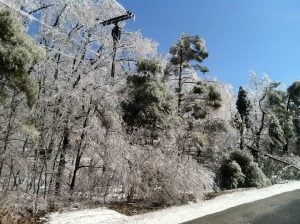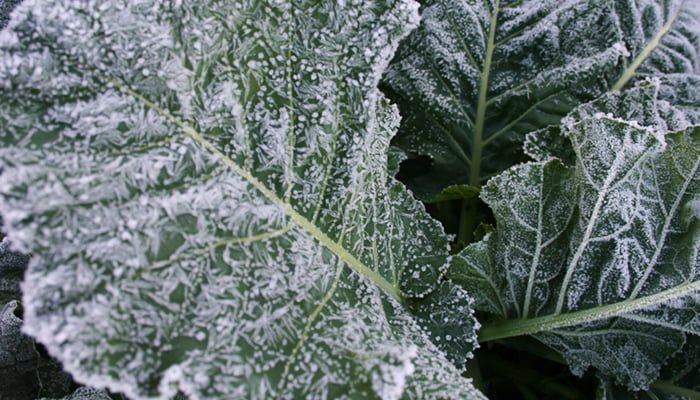This week we saw our first frost, and although we’ve had an extremely warm fall thus far, the temperatures are now starting to drop pretty low, especially at night. That being said, now is the time to begin preparing your landscape for such conditions, and to start thinking about protecting plants from frost.
Frost occurs when the air temperature approaches freezing. At this time, the surface temperature of plants can also dip below freezing causing ice crystals to form in the same way that dew forms on warmer nights. Temperatures vary significantly near the ground, and because of this, you may see some frost formation, even on nights that do not hit below freezing.
There are several different types of frost:
- Hoarfrost – This is the feathery white frost on chilly mornings that results from water in the air depositing directly in the form of ice crystals.
- Rime – This happens when water is deposited in liquid through dew or fog that then freezes. This type of frost has a more glazed appearance.
- Black frost – This can be looked at as similar to black ice – you can’t see it, but it can do some serious damage. The term refers to when frost did not actually form, but there was still damage to your plants from freezing temperatures. These damaged plants may take on a blackened appearance.
Here is a breakdown of some of the damages frost can have on your landscape:
- If the temperature is around 28 degrees F for a couple of hours and a light frost/freeze occurs, this will usually only harm very tender plants, as ice will only form on the outside of the plant.
 If the temperature gets down to between 25-28 degrees F for several hours, hard frost will form with a moderate freeze. This type of frost can be damaging and potentially deadly. Ice can form on the inside of the plant causing cells to burst. This type of frost will likely damage foliage and blossoms and can damage crops.
If the temperature gets down to between 25-28 degrees F for several hours, hard frost will form with a moderate freeze. This type of frost can be damaging and potentially deadly. Ice can form on the inside of the plant causing cells to burst. This type of frost will likely damage foliage and blossoms and can damage crops.- Anything below 25 degrees F for several hours will cause severe freezing and damages and drying to plants.
So, how can you prevent these damages, and protect your plants and landscaping from this season’s frost?
- Watering plants – It is important to thoroughly water your plants before an expected freezing. This helps to prevent drying and to add insulation to the soil and plant cells. Moist soil holds heat longer than dry soil. However, overwatering can lead to root and crown rot diseases.
- Bring mobile plants indoors – If you have any plants in containers that can easily be moved indoors, you may want to consider bringing them inside for the winter.
- Cover vegetables and cold sensitive landscape – When temperatures are expected to fall below 25 degrees F, your vegetables and cold sensitive landscaping should be covered with row covers or blankets. Covers should extend down to the ground, and should be securely held down.
- For larger shrubs, adding a wire cage around individual plants and mulching can help them to survive frost damages.
The best way to protect your landscaping from frost damages is prevention methods and being proactive. This begins with planting the proper/best trees and plants for your climate. A knowledgeable and trained professional can help to determine which plants will survive and thrive best in your home’s climate. If tender plants can be planted in mobile containers or planters so they can be moved inside during the colder months, this is ideal. Being proactive means preparing your landscape before the frost comes.
It is also important to assess the damages before assuming that your plants are lost for good. It may be possible for your trees, perennials, and shrubs to recover even if visibly damaged. Once they begin actively growing again, you will be able to determine their status. They may just require some pruning and/or maintenances to help bring them back to a thriving state. The trained staff at Red Cedar can help determine damages associated with harsh weather, and can also help to nurse your trees and shrubs back to health. We can also evaluate to determine if any of the trees on your property have any damaged or hazardous limbs that need to be removed.
Now is the time to prepare your gardens, plants, trees, and landscaping for the colder months. Being prepared decreases the chances of severe damage to your landscape, and increases the chances of recovery during the next growing season. For all of your tree, shrub, and landscaping needs, contact Red Cedar and get a free comprehensive consultation!


